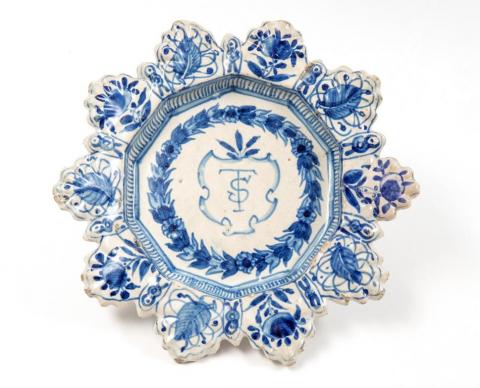Salva com Pé
Footed Salver
Portuguese faience “Pré-Aranhões”
Lisbon, second-quarter of the 17th century
Diam.: 22,0 cm
Prov.: Private collection, Alcobaça
Pub.: «Lisboa na Origem da Chinoiserie», Lisboa, 2018, p. 104
Faiança portuguesa, decoração “Pré-Aranhões"
Lisboa, Séc. XVII (2º quartel)
Diam.: 22,0 cm
Prov.: Colecção particular, Alcobaça
Pub.: «Lisboa na Origem da Chinoiserie», Lisbon, 2018, p. 104
Unusual small sized moulded salver of jagged cut–out lip, decorated in cobalt-blue pigment on tin-white enamel. Within the decagonal central section a flower and foliage crown encircling a cartouche monogrammed “T S”, often present in pieces associated to the city of Hamburg or to the Hanseatic League, the whole composition framed by a band of parallel vertical stripes.
On the lip a sequence of ten cut-out sections alternating artemisia leaves and peaches, separated by small columns with bows and seals. On the reverse, five polygonal sections of Chinese Ming – Wanli inspiration, filled by simple stylised floral detailing and a circular raised foot encircled by parallel blue filleting.
This rare salver, similar to other pieces of identical decoration in Portuguese collections, was originally produced for export to the German Hamburg market as evidenced by the “T S” monogram and the foliage crown, both details repeated in a bottle made in Lisbon and dated to circa 1648, that can be seen at the Museum für Kunst und Gewerb in Hamburg (Inv. nº 1930.102).
The salver’s shape alludes to 17th century Portuguese silver footed salvers and its decoration, of clear hybridisation, reflects the blending of a strong Kraak matrix, on the lip, with a monogram framed by a foliage crown in the Northern European taste.
For similar piece see: BAUCHE, Ulrich, Lissabon – Hamburg Fayenceimport Für Den Norden, Hamburg, Museum Für Kunst und Gewwerbe, 1996, p. 43, fig. 26.
Invulgar salva com pé, moldada, de pequeno formato e aba inteiramente recortada, coberta de esmalte estanífero branco, com decoração pintada a azul-cobalto.
Covo poligonal, delimitado por friso com dupla moldura e preenchido por traços paralelos verticais. O fundo está envolvido por coroa de flores e folhagem, centrado por cartela com os monogramas T e S sobrepostos, inicias encontradas em outras peças ligadas à cidade de Hamburgo ou à Liga Hanseática.
A aba é formada por 10 reservas recortadas, preenchidas alternadamente por folhas de artemísia e pêssegos, separadas por colunelos com laços e selos, também recortados.
No tardoz, cinco reservas poligonais ao gosto Ming - Wanli, com apontamentos florais e pé circular envolvido por filetes pintados.
Esta raríssima faiança, apesar da sua semelhança com outras peças de decoração idêntica em colecções portuguesas, foi produzida para o mercado alemão de Hamburgo, conforme se pode constatar pela cartela com o monograma “T S” e a coroa de folhagem envolvente, iguais aos que decoram a frente de uma garrafa de cerca de 1648, produzida em Lisboa, existente no Museum für Kunst und Gewerbe, de Hamburgo (Inv. nº 1930.102).
A forma remete para as salvas de pé seiscentistas portuguesas em prata e a decoração é hibrida, com uma aba de forte cariz Kraak, centrada num monograma envolvido por coroa de folhas e folhagem ao gosto do norte da Europa.
Peça idêntica: BAUCHE, Ulrich, Lissabon – Hamburg Fayenceimport Für Den Norden, Hamburgo, Museum Für Kunst und Gewwerbe, 1996, p. 43, fig. 26.
- Arte Portuguesa e Europeia
- Azulejos e Faianças

